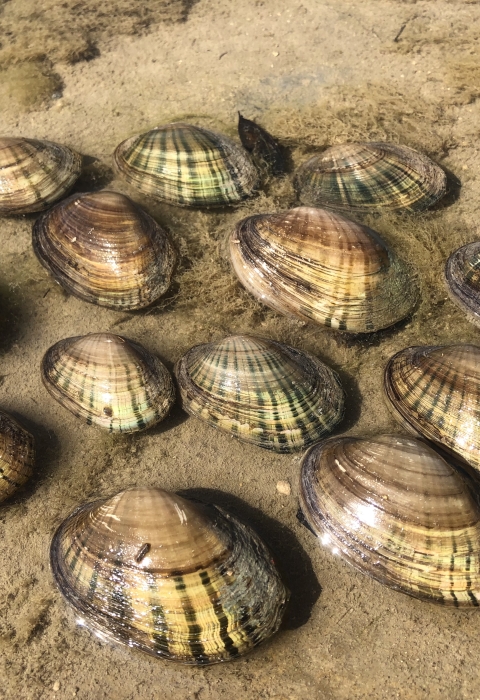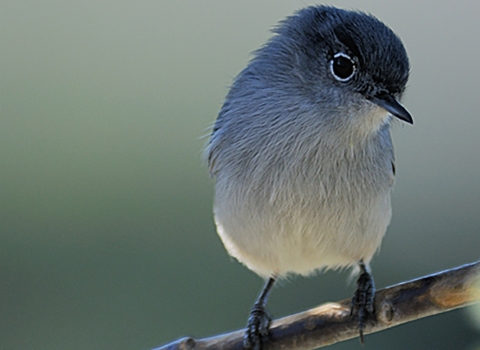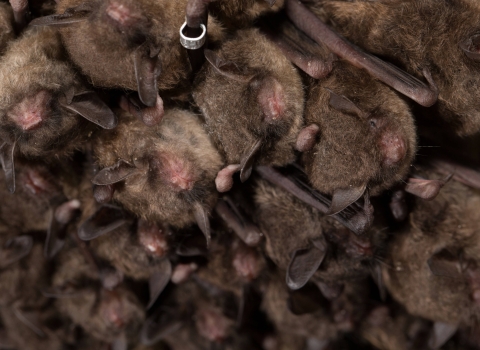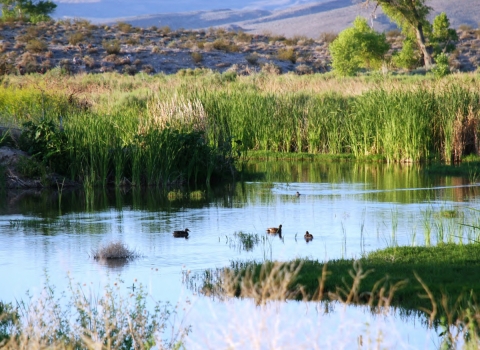The U.S. Fish and Wildlife Service (Service) is seeking public comment for a proposed Candidate Conservation Agreement with Assurances (CCAA) for four freshwater mussels in the lower Colorado River basin in Texas. The 20-year agreement with the Lower Colorado River Authority (LCRA) and Lower Colorado River Authority Transmission Service Corporation (LCRA TSC) would address the conservation needs of the Texas pimpleback, Texas fawnsfoot, Texas fatmucket, and Balcones spike while providing regulatory certainty to LCRA’s water management operations in the river basin.
“This conservation agreement with LCRA demonstrates their commitment to conserving native species like freshwater mussels, which are among the most endangered species on the planet,” said Amy Lueders, the Service’s Southwest Regional Director. “In return for implementing voluntary conservation measures for these species, the CCAA gives LCRA assurance that they can continue to meet the needs of water users throughout the river basin should an Endangered Species Act (ESA) listing occur.”
A CCAA is a formal, voluntary agreement between the Service and non-federal landowners to conserve habitat that benefits at-risk species. In return, participants receive assurances that no additional conservation measures will be required if the covered species is listed as threatened or endangered under the ESA. The Service provides these assurances through an “enhancement of survival” permit, giving authorization to participating landowners for take that is incidental to conservation and ongoing activities covered by the CCAA.
CCAAs are intended to reduce or remove identified threats to a species. A number of factors threaten freshwater mussels, includingdeclines in water quality, loss of stream flow, riparian riparian
Definition of riparian habitat or riparian areas.
Learn more about riparian and instream habitat fragmentation, and degradation of instream habitats. Urbanization and changes in climate patterns exacerbate these effects.
Conservation measures outlined for the mussels in LCRA’s CCAA include addressing water quantity, water quality, and invasive species invasive species
An invasive species is any plant or animal that has spread or been introduced into a new area where they are, or could, cause harm to the environment, economy, or human, animal, or plant health. Their unwelcome presence can destroy ecosystems and cost millions of dollars.
Learn more about invasive species , as well as freshwater mussel enhancement and protection and land conservation.
The species covered under the agreement include the Texas fawnsfoot, which is currently proposed for listing as threatened under the ESA. It occurs in the San Saba River and in the Colorado River.
The Texas pimpleback is currently proposed for listing as endangered under the ESA. It occurs in portions of the Colorado River basin, Texas, including the Elm, Colorado, Concho, Llano, San Saba, and Pedernales rivers as well as Bluff Creek
The Texas fatmucket is also currently proposed for listing as endangered under the ESA. It occurs in portions of the Colorado River basin, including the San Saba, Llano, North Llano, South Llano, James, and Pedernales rivers as well as Bluff, Cherokee, Elm, Threadgill, Live Oak, Onion, and Rocky creeks.
The Balcones spike, recently discovered to be a unique species and split off from the false spike, occurs in the Colorado and Brazos River basins.Currently, the Balcones spike occurs in two populations in the Colorado River basin, in the lower San Saba and Llano Rivers.
Healthy aquatic systems are important for fish, waterfowl and other wildlife as well as human communities, businesses, and economic enterprises. Efforts and actions to improve the water quality and quantity of rivers and streams that freshwater mussels depend upon will also benefit the human communities and businesses dependent on these water sources.
The Service’s priority is to make implementation of the ESA less complex, less contentious and more effective. We seek to accelerate recovery of threatened and endangered species across the nation, while making it easier for people to coexist with these species. In addition to LCRA and the Brazos River Authority, which finalized a similar agreement last year, the Service has been working with several other Texas river authorities to develop CCAA’s to benefit at-risk and imperiled species in Texas.
Research focused on helping improve the understanding of the species has been funded by the Office of the Texas Comptroller, Texas Parks and Wildlife Department, the Service, and others.
The Service encourages the public to review and provide comments on the documents during the 30-day public comment period. Information on how to obtain or review copies of these documents, or how to provide comments can be found here: https://www.fws.gov/library/collections/lower-colorado-river-authority-candidate-conservation-agreement-assurances.
Q. What action is the U.S. Fish and Wildlife Service (Service) taking?
A. The Service is announcing the public comment period for a Candidate Conservation Agreement with Assurances (CCAA) with the Lower Colorado River Authority (LCRA) and Lower Colorado River Authority Transmission Service Corporation (LCRA TSC) for freshwater mussel conservation, which covers surface water supply, delivery operations, and maintenance activities in the middle and lower Colorado River basin in Texas.
The CCAA, and associated Enhancement of Survival (EOS) permit, would be in effect for 20 years and authorizes incidental take of the Texas pimpleback, Texas fawnsfoot, Texas fatmucket, and Balcones spike. The incidental take would result from activities associated with otherwise lawful activities, including implementation of the conservation strategy and conservation measures, and ongoing and continuing water supply development activities.
Q. What is a CCAA?
A. CCAAs are voluntary agreements that provide non-federal landowners, industry, local government and others the opportunity to implement conservation practices that address specific threats with assurances that, if the species is listed, they can continue to manage their land and waters as outlined in their agreements with no additional requirements. If a species is listed and a CCAA is in place, those entities enrolled in the CCAA will not be required to do more than they have agreed to do under the agreements.
Q: Where are the mussel species found, and what are the threats to the species?
A: A number of factors threaten these mussels, includingdeclines in water quality, loss of stream flow, riparian and instream habitat fragmentation, and degradation of instream habitats. Urbanization and changes in climate patterns exacerbate these effects.
The Texas fawnsfoot was proposed for listing as threatened under the ESA in 2021. It occurs in the Brazos, Colorado and Trinity River basins, Texas. In the Colorado basin, Texas fawnsfoot occurs in the San Saba River and in the Colorado River. Texas fawnsfoot are threatened by water quality decline and small population sizes.
The Texas pimpleback was proposed for listing as endangered under the ESA in 2021. It occurs in portions of the Colorado River basin, Texas, including the Colorado, Concho, Llano, San Saba, and Pedernales rivers as well as Elm and Bluff creeks. This species has very little evidence of reproduction in all but one population, and the drought of 2011-13 likely resulted in the extirpation of at least one population.
The Texas fatmucket was proposed for listing as endangered under the ESA in 2021. It occurs in portions of the Colorado River basin, Texas, including the San Saba, Llano, North Llano, South Llano, James, and Pedernales rivers as well as Bluff, Cherokee, Elm, Threadgill, Live Oak, Onion, and Rocky creeks. This species occurs in headwater streams that are very susceptible to drying.
The Balcones spike was recently discovered to be a unique species and split off from the false spike that was once thought to be extinct but was rediscovered in 2011. The Balcones spike only occurs in the Brazos River and Colorado River basins, while the false spike only occurs in the Guadalupe River basin. Currently, the Balcones spike occurs in three populations: in the Little River and some tributaries in the Brazos River basin, and the lower San Saba and Llano Rivers in the Colorado River basin.
Q. Is the Balcones spike proposed for listing under the ESA?
A. In September 2020, the false spike was split due to new taxonomic information. The populations in the Guadalupe River basin remained the false spike, while the Brazos and Colorado River basin populations are now known as the Balcones spike. In 2021, the Service proposed to list the false spike as an endangered species along with five other Central Texas mussel species. The Service recognizes the Balcones spike and false spike as two separate and unique species. In the event the false spike proposed listing is finalized, the closely related Balcones spike will also receive protection under the ESA.
Q. How will the CCAA benefit the mussel species?
A. CCAAs are intended to reduce or remove identified threats to a species. Conservation measures outlined for the mussels in the LCRA CCAA include addressing water quantity, water quality, and invasive species, as well as freshwater mussel enhancement and protection and land conservation.
Water quality measures include conducting routine water quality monitoring of sites near existing freshwater mussel populations, continued implementation of the Highland Lakes Watershed Ordinance to reduce water quality impacts from nonpoint source pollution in areas surrounding the Highland Lakes, and continued implementation of On-Site Sewage Facilities program to reduce water pollution from septic systems in areas surrounding the Highland Lakes.
Water quantity measures include providing water for environmental flows protection in the Colorado River below Austin and collaborating with the Service and Texas Parks and Wildlife Department (TPWD) to develop and implement a contingency plan for freshwater mussels, including short-term refugia.
Invasive species measures include monitoring for zebra mussels and all other invasive aquatic species in the Colorado River below Longhorn Dam to better understand the known and potential threats to freshwater mussels and helping to reduce spread of aquatic invasive species by adhering to invasive species spread prevention plan and conducting public outreach/education (in collaboration with TPWD).
Population enhancement and protection measures include maintaining the raw water contract with the Service for the Inks Dam National Fish Hatchery, which provides 100 ac-ft per year of water at no cost, as an in-kind contribution to the captive propagation effort; collaborating with the Service and others to help support captive propagation studies; funding the mark-recapture project that was initiated with funding by TX Comptroller and conducted by BIO-WEST and Texas State at the middle and lower Colorado River sites and expanded at the lower Colorado River site to provide additional habitat suitability science; partnering with the Service to conduct an assessment of stream reaches for conservation and restoration prioritization of habitat for Covered Species and other native freshwater mussels; a mussel survivability study in the lower Colorado River below Austin to apply results of habitat assessment; funding mussel tolerance studies and applied research to help further develop science on mussel needs; leading or assisting, as needed, the development of a statewide coordinated monitoring and research web platform for mussel biologists throughout the state; and working with the Service to develop a contingency plan for short-term refugia.
Land conservation measures include LCRA Creekside Conservation Program, which provides cost-sharing grants to help eligible landowners plan and implement conservation practices that reduce soil erosion and protect water quality; working with land trusts and other land conservation organizations in the basin to prioritize opportunities for placing key properties under conservation easements; educational outreach to landowners and land trusts in key areas of the watershed to provide information on land management strategies to protect watershed health; and organizing and helping lead a work group for the Onion Creek Texas fatmucket population and section of the Colorado River downstream of Longhorn Dam within Travis County.
While the conservation measures outlined in the document are designed to benefit these four species specifically, they should benefit a variety of aquatic species, including amphibians, fish, and macroinvertebrates.
Q. Why are freshwater mussels important?
A. Mussels are biological indicators of healthy streams and rivers that benefit people and wildlife. The presence of diverse and reproducing mussel populations indicates healthy ecosystems, good fishing, and high water quality for waterfowl and other wildlife species. They also provide assurances that our water is safe.
Mussels perform important ecological functions. They are natural filters, and by feeding on algae, plankton, and suspended detritus and silts, they help purify the aquatic system. Mussels are also an important food source for many species of wildlife including otters, raccoons, muskrats, herons, egrets, and some fish.
Q. Are there other conservation efforts that are being implemented for the mussels?
A. The Texas Comptroller of Public Accounts has established an endangered species research program that has funded multiple scientific investigations related to freshwater mussels in Texas. The Comptroller’s Office funded $3.6 million in studies relevant to the Central Texas freshwater mussels. These investigations involved multiple researchers from several public universities in Texas. The most recent funding established refugia and propagation facilities for these species of freshwater mussels at the Service’s San Marcos Aquatic Resources Center, Inks Dam and Uvalde National Fish Hatcheries. This research has been followed by a partnership between the San Antonio River Authority, San Marcos Aquatic Resources Center, and Inks Dam National Fish Hatchery to further develop propagation techniques.
Several universities also are researching freshwater mussels, including Texas A&M University, Texas State University, Baylor University, the University of Texas at Austin, the University of Texas at Tyler, and Auburn University. These studies include surveys to identify new populations, genetic investigations, and tolerance studies.
The TPWD and nongovernmental organizations led efforts to protect and enhance habitats within the river basins occupied by central Texas mussels. TPWD has worked with private landowners and others (including the Service) to restore approximately 10,000 acres of upland habitats in priority watersheds important for conservation of aquatic wildlife resources. TPWD also maintains the Texas Mussel Watch Program, where members of the public can submit their observations of mussels to help gain a better understanding of the distribution and status of mussels. In addition to regulating commercial harvesting of mussels, TPWD also regulates the take of mussels by individuals by requiring a fishing license and freshwater fishing endorsement.
The Service’s Fish and Aquatic Conservation Program and others are evaluating methods to propagate the central Texas mussels. The Service’s Partners for Fish and Wildlife Program, and other partners, are working with private landowners interested in riparian and instream habitat restoration and enhancement.





